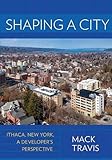Shaping a City : Ithaca, New York, a Developer's Perspective / Mack Travis.
Material type: TextPublisher: Ithaca, NY : Cornell University Press, [2018]Copyright date: ©2018Description: 1 online resource (320 p.) : 112 b&w halftones, 2 mapsContent type:
TextPublisher: Ithaca, NY : Cornell University Press, [2018]Copyright date: ©2018Description: 1 online resource (320 p.) : 112 b&w halftones, 2 mapsContent type: - 9781501730153
- Central business districts -- New York (State) -- Ithaca -- History
- City planning -- New York (State) -- Ithaca -- History
- Real estate development -- New York (State) -- Ithaca -- History
- Urban renewal -- New York (State) -- Ithaca -- History
- Architecture & Preservation
- New York History
- Urban Studies
- SOCIAL SCIENCE / Sociology / Urban
- Community Collaboration as self-interest, Strategic City Planning, Community projects, Historic Preservation, Arts, Dining, & Entertainment
- 333.3309747/71 23
- HD268.I8 T73 2018
- HD268.I8
- online - DeGruyter
| Item type | Current library | Call number | URL | Status | Notes | Barcode | |
|---|---|---|---|---|---|---|---|
 eBook
eBook
|
Biblioteca "Angelicum" Pont. Univ. S.Tommaso d'Aquino Nuvola online | online - DeGruyter (Browse shelf(Opens below)) | Online access | Not for loan (Accesso limitato) | Accesso per gli utenti autorizzati / Access for authorized users | (dgr)9781501730153 |
Browsing Biblioteca "Angelicum" Pont. Univ. S.Tommaso d'Aquino shelves, Shelving location: Nuvola online Close shelf browser (Hides shelf browser)

|

|

|

|

|

|

|
||
| online - DeGruyter LaGuardia in Congress / | online - DeGruyter The Perraults : A Family of Letters in Early Modern France / | online - DeGruyter The One, Other, and Only Dickens / | online - DeGruyter Shaping a City : Ithaca, New York, a Developer's Perspective / | online - DeGruyter Coves of Departure : Field Notes from the Sea of Cortez / | online - DeGruyter American Labyrinth : Intellectual History for Complicated Times / | online - DeGruyter Dark Pasts : Changing the State's Story in Turkey and Japan / |
Frontmatter -- CONTENTS -- Acknowledgments -- Introduction -- 1. The Commons (1971–75): A Pedestrian Mall -- 2. CLUG: A Lesson in City Planning -- 3. The Strategy (1973–92): Quality Housing -- 4. Center Ithaca (1980–94): A Financial Failure -- 5. The BID (1993–95): A Business Improvement District -- 6. A Second Attempt (1996–98): Success -- 7. Arrival (1999): The Candidate -- 8. The Strategic Plan (1999–2000): Headed Up or Headed Down? -- 9. Crisis (2000): A Postal Disaster -- 10. Gateway Plaza (2001): Survival, Vision, and Tax Abatements -- 11. The Hotel (2002–5): Throwing Down the Gauntlet -- 12. Behind the Scenes: Growing the Market -- 13. Gateway Commons (2005–6): The Pride Project -- 14. The Ripple Effect: Do You Believe? -- 15. The Out-of-Town Developers (2003–15): A Study in Perseverance -- 16. Other Forces at Work: IURA, TCAD, Historic Ithaca, ILPC, and IDA -- 17. “Changing People’s Lives”: Ithaca Neighborhood Housing Services -- 18. The Whole County (1974–2010): The South Hill Business Campus -- 19. Looking Back at the Strategic Plan (2000–2010): The End of a Decade -- 20. Looking Ahead (2010–20): The 2020 Strategic Plan -- 21. Density: Seneca Way (2010–12)—One Vote! -- 22. Collegetown Terrace (2007–17): Breaking out of the Mold -- 23. Community Focus (1828–2008): Avoiding a Bankruptcy -- 24. Opportunities (2008–15): A Successful Collaboration -- 25. Nonprofi t Survival: How to Improve the Bottom Line through Real Estate Ownership -- 26. The Women’s Community Building (1960–2014): Breckenridge Place- AffordableHousing in the Heart of Downtown -- 27. You Don’t Always Win (2012–13): Public Service Meets an Immovable Object -- 28. Shifting Emphasis (2013): A Family Business -- 29. Devil in the Details (2014): Synergy and the Big Picture -- 30. Coltivare (2011–14): Farm to Bistro -- 31. Rezoning (2013–14): Overzealous? -- 32. Cornell Program in Real Estate (2014–15): The Class -- 33. A Corporate Commitment (2016–18): Since 1836 -- 34. The Next Generation: They Get It! -- 35. Where Do We Go from Here? The Road Forward -- Afterword -- Appendix: “Growing Up and Out” by Karen Gadiel and Interview with Gary Ferguson -- Bibliography -- Index
restricted access online access with authorization star
http://purl.org/coar/access_right/c_16ec
Picture your downtown vacant, boarded up, while the malls surrounding your city are thriving. What would you do?In 1974 the politicians, merchants, community leaders, and business and property owners, of Ithaca, New York, joined together to transform main street into a pedestrian mall. Cornell University began an Industrial Research Park to keep and attract jobs. Developers began renovating run-down housing. City Planners crafted a long-range plan utilizing State legislation permitting a Business Improvement District (BID), with taxing authority to raise up to 20 percent of the City tax rate focused on downtown redevelopment.Shaping a City is the behind-the-scenes story of one developer’s involvement, from first buying and renovating small houses, gradually expanding his thinking and projects to include a recognition of the interdependence of the entire city—jobs, infrastructure, retail, housing, industry, taxation, banking and City Planning. It is the story of how he, along with other local developers transformed a quiet, economically challenged upstate New York town into one that is recognized nationally as among the best small cities in the country.The lessons and principles of personal relationships, cooperation and collaboration, the importance of density, and the power of a Business Improvement District to catalyze change, are ones you can take home for the development and revitalization of your city.
Mode of access: Internet via World Wide Web.
In English.
Description based on online resource; title from PDF title page (publisher's Web site, viewed 26. Apr 2024)


